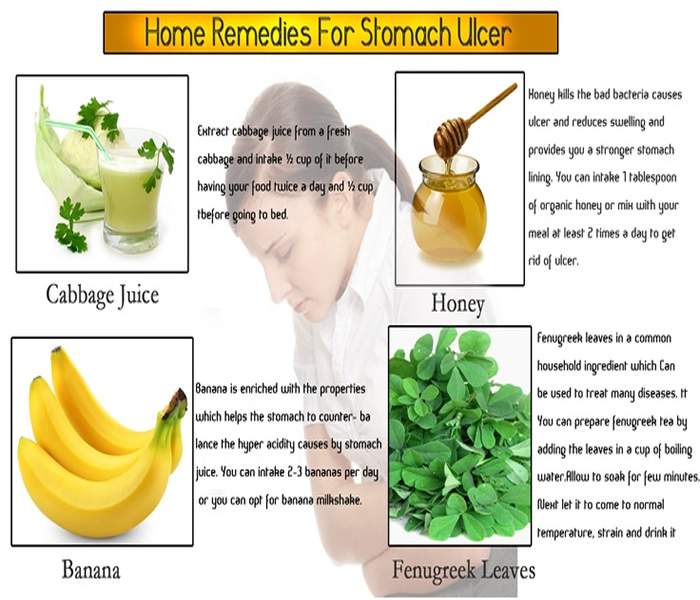Stomach Ulcer
What Is Stomach ulcer?
Stomach ulcers are painful sores that can be found in the stomach lining or small intestine, it is one of peptic ulcer.
They occur when the thick layer of mucus that protects your stomach from digestive juices is reduced, thus enabling the digestive acids to eat away at the lining tissues of the stomach.
A stomach or gastric ulcer is a break in the tissue lining the stomach. It is usually caused by an infection with a germ (bacterium) called Helicobacter pylori (H. pylori).
A stomach ulcer is also known as gastric ulcer. The most common type of peptic ulcer is a duodenal ulcer.

Note:
Stomach ulcers are easily cured, but they can become severe without proper treatment.
Causes of Stomach ulcer
The decrease in the stomach's mucus lining that leads to an ulcer is usually caused by one of the following:
- An infection with the bacterium Helicobacter pylori (H. pylori)
- Long-term use of nonsteroidal anti-inflammatory drugs, such as aspirin and ibuprofen.
- Many people take NSAIDs without having any side effects, but there's always a risk the medication could cause problems, such as stomach ulcers, particularly if taken for a long time or at high doses.
- Cancer: stomach cancer can present as an ulcer, particularly in older people.
- Causes by Lifestyle factors
- Not eating food on time (Eating Late)
- Too much of spicy foods
- Stress
- Drink too much of alcohol
However, it is thought that smoking increases your risk of developing stomach ulcers and may make treatment less effective.
Symptoms/Signs of Stomach ulcer
Burning pain is the most common peptic ulcer symptom. The pain is caused by the ulcer and is aggravated by stomach acid coming in contact with the ulcerated area. There are other signs which include:
- Abdominal pain just below the ribcage
- Bloating
- Bright or altered blood present in vomit or bowel motions
- Burping or acid reflux
- Dark blood in stools or stools that are black or tarry
- Heartburn (burning sensation in the chest)
- Indigestion
- Nausea
- Loss of appetite
- Symptoms of anemia, such as light-headedness
- The vomiting of blood — which may appear red or black
- Shock due to blood loss which require medical attention (medical emergency).
- Weight loss
How to diagnose Stomach ulcer
To confirm a person has an ulcer a diagnostic imaging test will usually be ordered. The two most widely used tests are:
Upper GI series (UGI): This is a type of X-ray. The patient is given a chalky liquid to drink that increases the contrast on the X-ray, making certain features easier to see. Because this liquid contains barium, this test is sometimes called a barium swallow.
Endoscopy (EGD): An endoscope is a thin, flexible tube with a tiny camera at the end. The patient is given a mild sedative, and then the tube is passed through the mouth into the stomach. The doctor can see the lining of the stomach to diagnose a peptic ulcer. Tiny samples of the tissue will be taken (biopsy), which are examined under a microscope.
If a diagnostic imaging test reveals an ulcer, the patient will most likely have a test to see if H pylori bacteria are present. It is important to be certain about this, because treatment of the H pylori is likely to heal the ulcer.

Ulcers caused by H pylori are treated differently than ulcers caused by medications.
Three types of tests are available to detect H pylori.
Blood tests: These tests detect the bacteria by measuring antibodies to the bacteria. Antibodies are proteins produced by the immune system to defend against an "invader" such as H pylori. The blood test is inexpensive and can be done in a medical office. The down side is that it can be positive in a person who had an ulcer in the past and was already treated for it.
Breath test: This test detects H pylori by measuring carbon dioxide in the breath of a person who has drunk a special liquid. H pylori bacteria break down the liquid, increasing the amount of carbon in the blood. The body gets rid of this carbon by breathing it out as carbon dioxide. This test is more accurate than the blood test but is more difficult to carry out. It is often used after treatment to check whether H pylori bacteria have been eradicated.
Tissue tests: These tests are used only if an endoscopic biopsy has been done, because a sample of tissue from the stomach is needed to detect the bacteria.
How to Prevent Stomach ulcer
To event them returning, lifestyle changes include:
- Avoiding foods and drinks that give you more severe symptoms, such as alcohol
- Avoid eating late(Do not delay your breakfast, Lunch and Dinner)
- Avoiding painkillers that may cause ulcers in the future
- Not mixing alcohol with medication
- Quitting smoking
- Washing your hands frequently to avoid infections
- Antibiotics to kill the H. pylori bacteria and other drugs to help the ulcer to heal
- Changes to doses of mediation such as aspirin
- Ongoing medical breath tests to make sure H. pylori doesn't return again
- Tablets to reduce acid in the stomach
Vitamin E
Doctors at the Kiev Medical Institute reported that 300 mg of vitamin E daily effectively treated peptic ulcers of 28 patients. Ulcers were relieved in four to six days in the vitamin E group, while it took seven to ten days in those given conventional medication. Patients taking vitamin E also had increased protein repair in their intestinal linings and gained from 1.5 to 3 kg during the study, while the controls did not gain any weight.
Bananas
The sitoindosides in dried, unripe bananas increase mucus in the digestive tract, which provides a strong protective coating to help prevent and heal ulcers. Unripe bananas also promote cell growth in the intestinal tract. And bananas contain water-soluble polysaccharides, the same compounds found in the anti-ulcer prescription drug Carafate.
For ulcer treatment, unripe whole bananas will have some effect, but the best results are obtained with banana powder. To make banana powder, peel the bananas and cut them into thin slices. Put them in the sun, an oven, or a food dehydrator, and dry them slowly. When dry, grind them into a fine powder. Mix 2 tablespoons of the powder with 1 tablespoon of honey. Take this mixture three times a day: mid-morning, mid-afternoon, and at bedtime.
Honey
Honey possesses a number of curative powers and has been shown, in particular, to be an effective ulcer treatment for two reasons. First, glucose oxidase, an enzyme in honey, produces hydrogen peroxide, which kills harmful bacteria that can contribute to the development of ulcers. Then there are other floral antibacterial substances in honey, which come from flowers when bees collect pollen, that add to honey’s effectiveness in eliminating bacteria.
Certain varieties of honey, however, can be more effective than others at healing ulcers. I have reports from Saudi Arabia, where local honey was used to cure ulcers, and from doctors in Egypt and Russia, who have had positive results using their local honeys.
The key to successful ulcer treatment appears to hinge on it being natural, unprocessed honey. Two tablespoons a day should be about right for most types of honey. When the problem has eased, 1 tablespoon daily will probably be enough.
Garlic
I've often written about the miraculous powers of garlic and highly recommend its use in cooking. Research on its preventive and therapeutic benefits continues to grow. It now appears that garlic can keep levels of the Helicobacter pylori (H. pylori) bacterium in check. (An overgrowth of the H. pylori bacterium can contribute to the development of stomach ulcers.) Researchers at the Fred Hutchinson Cancer Research Center in Seattle discovered that garlic exhibits specific antimicrobial activity against H. pylori without entirely eliminating the strain. The elimination of H. pylori can cause other digestive woes.
Cabbage: As long as you have enough beneficial bacteria in your digestive tract, it should keep the disease-causing bacteria that can lead to ulcers in check. And one of the best ways to fortify the good bacteria in your gastrointestinal tract is by regularly including cultured and lactic acid–fermented foods in your diet. Foods such as homemade sauerkraut, yogurt, buttermilk, and pickled vegetables are all excellent for helping to maintain a healthy balance of gut bacteria.
But when it comes to ulcer treatment in particular, one lactic acid food stands out above the rest: cabbage juice. Decades before antibiotics, cabbage juice was successfully used to prevent or heal peptic and duodenal ulcers. In one study, it was shown that cabbage juice alone had a cure rate of over 92 percent in the treatment of these ulcers. This compared to about a 32 percent cure rate in those using a placebo or other treatment.
The dosage in the study consisted of only 50 mL of raw cabbage juice derived from a quart of freshly pressed cabbage. Based on numerous studies and early clinical work, researchers have begun to refer to this unknown ulcer-healing factor in cabbage as vitamin U.
Although in the above studies the cabbage juice wasn’t fermented, keep in mind that vegetables that grow close to the soil are naturally rich in beneficial lactic acid bacteria. That's why "starter cultures" aren't needed to ferment these vegetables, only salt and water. Cabbage is also a reliable source of vitamin C, which has been found to be lower in the gastric juice of ulcer patients. So if you have ulcers, cabbage juice is a safe, effective, and inexpensive remedy. If you "culture" it or give it a chance to ferment, you'll experience even more benefits.
Complications of Ulcer
In some cases complications develop and can be serious. These include:
Bleeding ulcer: This can range from a 'trickle' to a life-threatening bleed.
Perforation: This is where the ulcer goes right through (perforates) the wall of the stomach. Food and acid in the stomach then leak into the abdominal cavity. This usually causes severe pain and is a medical emergency.




